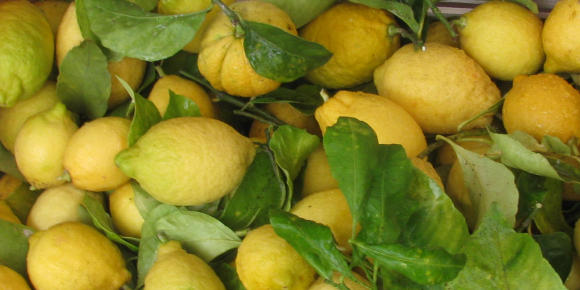
From the bulls in the Camargue to the olive trees of Provence, from the vineyards of the Rhone Valley to the lemon trees of Menton and from the fig trees of Solliès to the apple orchards of Haute Durance, the agriculture of southeast France offers a variety of stunning landscapes and notable products to travelers in search of local and regional gastronomy.
France Revisited’s Market Day in France series provides travelers with lists of appellations, geographic indicators and other labels that reveal the association of food and that is at the heart of market-based gastronomy in a given region.
The list below concerns France’s southeastern region, Provence-Alpes-Côte d’Azur (PACA). PACA covers Provence, the Riviera and southern half of the French Alps and pre-Alps. That’s more or less bordered by the Rhone River from Orange to Camargue to the west and by the Italian border from Menton to Briançon to the east.
The three major government labels for agricultural products used in France that ensure provenance and standards relative to specific products are AOP (Protected Designation of Origin), AOC (Controlled Appellation of Origin) and IGP (Protected Geographical Indication). Label Rouge (Red Label) is not necessarily associated with place but rather or general quality relative to similar products.
A brief description of these labels designates is given below this list. A fuller explanation can be found in the preface to this series, Market Day in France: Geography, Appellations and Terroir.
AOP, AOC, IGP and Label Rouge in Provence-Alpes-Côtes-d’Azur, including several that are currently under consideration by INAO, the governmental body that regulates French agricultural labels.
Links are provided for more information about specific products.

FRUITS and VEGETABLES
Citron de Menton, IGP
A large lemon grown on terraced orchards on the hills rising from the corner of the Riviera near the Italian border, in and around the towns of Castellar, Gorbio, Roquebrune-Cap-Martin, Saint-Agnès and Menton. (See photo at the top of the page.) Menton holds an annual Lemon Festival, during Mardi Gras season.
Figues de Solliès, AOC and AOP
Figs grown in the Gapeau Valley, just inland between Toulon and Hyères, ripe between mid-August and mid-November.
Melon de Cavaillon, currently under consideration for IGP
A type of cantaloupe, the charentais. See this article on France Revisited.
Muscat du Ventoux, AOC and AOP
A deep blue-black table grape from the center of Provence in markets from the end of August to December.
Cerises des Coteaux du Ventoux, currently under consideration for IGP
Cherries from the center of Provence
Pomme des Alpes de Haute Durance, IGP
Golden delicious and gala apples and related varieties grown on the southwestern edge of the Alps.
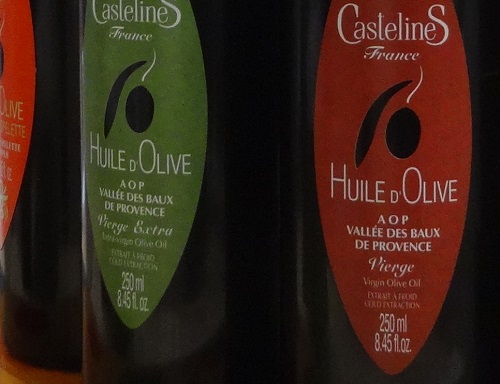
OLIVES and OLIVE OIL
Huile d’olive de Nice, AOC and AOP
Olive oil
Huile d’olive de Haute Provence, AOC and AOP
Olive oil
Huile d’olive de Provence, AOC
Olive oil
Huile d’olive d’Aix-en-Provence, AOC and AOP
Olive oil
Huile d’olive de la Vallée des Baux-de-Provence, AOC and AOP
Olive oil
Olive Noire de Nyons, AOC and AOP
Black olives. While the town of Nyons is located in Drome, which is part of the region just north of that covered in this list, a portion of the growing zone for this appellation is located in Vaucluse, which is in Provence.
Huile d’olive de Nyons, AOC and AOP
Olive oil. See note above regarding Nyons.
Olive noire and Olive verte cassée de la Vallée des Baux-de-Provence, AOC and AOP
Black olives and broken green olives.
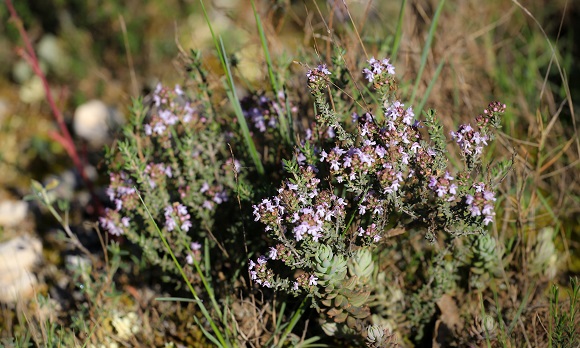
HERBS
Herbes de Provence, Label Rouge
Rosemary, oregano, savory and thyme
Thym de Provence, currently under consideration for IGP
Thyme
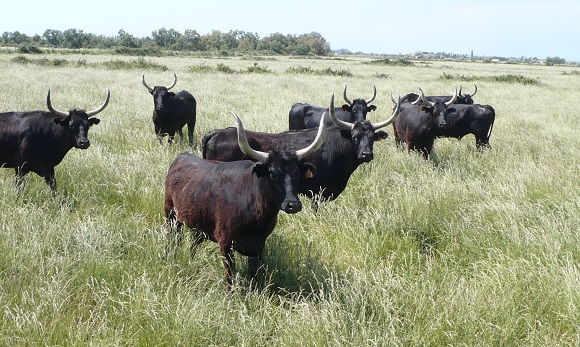
RED MEAT
Taureau de Camargue, AOC and AOP
Wide ranging bulls (two breeds) from the Camargue.
Agneau de Sisteron, IGP and Label Rouge
Lamb from Provence-Alpes-Côte d’Azur and Drôme Provençale.
Agneau de Crau (currently under consideration for IGP
Lamb
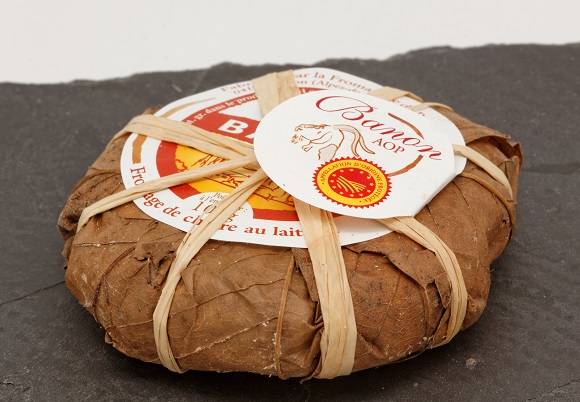
CHEESE
Brousse du Rove, currently under consideration for AOC
Cheese made from raw goat milk near Marseille and Aix-en-Provence
Banon, AOC and AOP
Cheese made from raw goat milk and wrapped in a chestnut leaf. The appellation zone covers portions of Alpes-de-Haute-Provence, Hautes-Alpes, Vaucluse and Drôme.

WINE, lots of it
Wine is undoubtedly the product that travelers most associated with appellations since French wines, whether blends or nots, are historically designated by provenance rather than grape.
8 AOC – AOP in Provence
Bandol, Cassis, Coteaux d’Aix-en-Provence, Coteaux Varois en Provence, Côtes de Provence, Les Baux de Provence, Palette, Pierrevert.
11 AOC – AOP in the southern portion of the Rhone Valley
Beaumes-de-Venise, Châteauneuf-du-Pape, Côtes du Rhône, Côtes du Rhône Villages, Gigondas, Luberon, Muscat de Beaumes-de-Venise, Rasteau, Saint-Joseph, Vacqueyras, Ventoux.
8 IGP in the region
Alpes-de-Haute-Provence, Alpilles, Bouches-du-Rhone, Hautes-Alpes, Maures, Méditerranée, Sable de Camargue, Var, Vaucluse.
GRAIN
Petit Épeautre de Haute Provence, IGP
Spelt (a type of wheat) from upper-eastern Provence
Riz de Camargue, IGP
Rice from the Camargue
HONEY
Miel de Provence, IGP
Honey from Provence. Honey gathered in Provence may also bear deemed Label Rouge.
CANDY
Calissons d’Aix-en-Provence, currently under consideration for IGP
A candy made from ground almonds and candied fruit topped with a thin icing, said to have been made in the area since the 15th century.
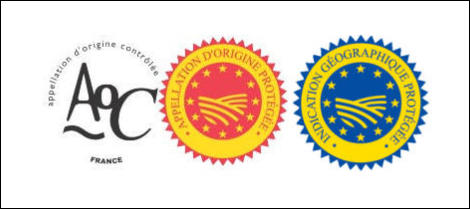
DEFINITIONS
The three major labels used France that ensure provenance and standards relative to a agricultural products are AOP (Protected Designation of Origin), AOC (Controlled Appellation of Origin) and IGP (Protected Geographical Indication).
These labels are essentially based on the notion of terroir, loosely translated as soil or simply place, signifying that the quality of certain products is intimately related to the interplay between their geographic zone of production (related to the zone’s geology, climate, agriculture and history) and the conditions and know-how involved in their production. The name of the place in a given appellation does not mean that the product comes only from within the limits of that town or village. The product can also come from wider geography, depending on the specs associated with that specific appellation.
AOP (Appellation d’origine protégée), or PDO (Protected Designation of Origin), is a protection given to a product within the European Union that designates a product whose geographic zone (geology, climate, agriculture and history) and principal production follow a well-established technique.
AOC (Appellation d’Origine Contrôlée or Controlled Appellation of Origin) is the French equivalent of the AOP. It is an older label.
IGP (Indication géographique protégée), or PGI (Protected Geographical Indication), identifies an agricultural product, raw or processed, including wine, whose quality, reputation or other characteristics are linked to its geographical origin.
Two other labels that our traveler will encounter are LR and AB.
Label Rouge (LR) or Red Label is a national sign given to products which, due to their terms of production or manufacture, have a higher level of quality compared to other similar products usually marketed. It isn’t in itself necessarily related to geography but rather to defined specifications for the type of product. Nevertheless, that product may in fact be related to a specific geographical zone.
The label AB, indicating organic farming (agriculture biologique), is not an indicator a specific geographic zone. Organic farming can, however, be involved in producing a product that bears one of the labels or appellations previously described. In that case the product can bear both a geographic appellation/indication and the AB label.
© 2016, Gary Lee Kraut

